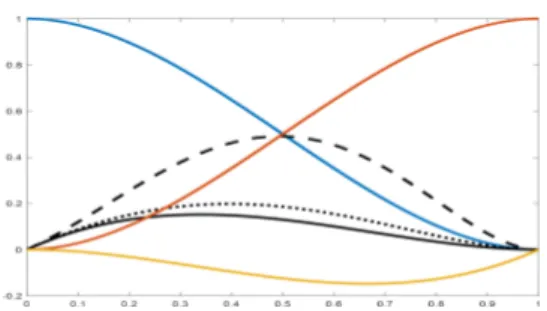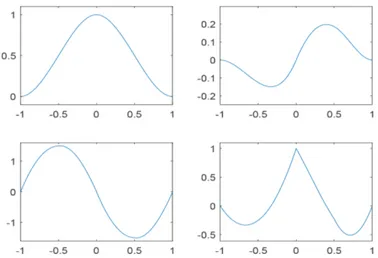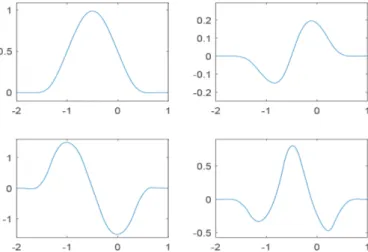M. Cotronei
SOME CONSTRUCTIONS OF LEVEL-DEPENDENT HERMITE
SUBDIVISION OPERATORS
Abstract. The aim of this short note is to present a strategy for constructing Hermite sub-division operators preserving elements in the space of polynomials and exponentials. The masks associated to such operators are suitable for processing data of Hermite type, where such data exhibit trascendental features, and can be used for the realization of novel wavelet systems.
1. Introduction
Hermite subdivision schemes have been a popular topic of research for many years. Such schemes have been firstly investigated by Merrien [14] and by Dyn and Levin [10], and successively studied by many authors ([3, 4, 8, 9, 12, 15, 18, 19] just to mention a few of them).
We recall that an Hermite scheme is an iterative procedure which acts on vector-valued data sequences c ℓd 1 Z , interpreting the j-th components as a j-th
deriva-tive. Starting from a vector of control points c0 c0
k k Z, with ck0 Rd 1
repre-senting function values and derivatives up to the d-th order, it produces sequences of sequences by means of the following rule:
(1.1) Dn 1cn 1 j
k Z
Aj 2kn Dncn
k , j Z, n 0,1,2,...,
where D is the diagonal matrix with elements 1,1 2,...,1 2d.
In a more compact notation, the above formulas read as Dn 1cn 1
S
AnDncn, n 0,1,2,...,
where
S
An is the Hermite subdivision operator at level n. These operators are, ingeneral, level-dependent, for they depend on d 1 d 1 matrix masks Akn k Z
which possibly vary at each iteration n of the subdivision process.
In particular, such level-dependency is unavoidable if the operator is required to preserve polynomial and exponential functions, that is elements in the space
Vd,Λ span 1,x,...,xp,eλ1x, . . . ,eλrx ,
where we have setΛ λ1, . . . ,λr
C
0 ,λi λj, i j, and d p #Λ p r.The use of subdivision schemes with this property is required when, for exam-ple, one wishes to process data that possess transcendental, rather then just polynomial, characteristics. Schemes of this type have been studied and realized, for example, in [11, 17], in the non-Hermite case and in [1, 2, 5, 6, 7, 13, 16], in the Hermite situation.
A thorough study of these operators and associated schemes has recently been carried out in [1, 2, 7, 6]. In some of such papers, examples of schemes have been given, all relying on the presence of double frequencies (i.e. λ) in Vp,rand all being
interpolatory.
In this short note, inspired by the examples of Hermite subdivision schemes pro-posed by Dubuc and Merrien in [9], we would like to illustrate a different construction, based on the results given in [1], but relaxing the double frequency constraint.
Like in the above-mentioned papers, we assume that the size d 1 d 1 of the matrices in the masks correspond to the order of the derivatives 0,1,...,d, involved. It turns out that the obtained operators produce, in the limit, those of the standard Hermite schemes realized in [9], which reproduce polynomial data only, since they satisfy the polynomial spectral condition, obtained as a particular case of (1.2) when the function f is in the space of polynomials of degree less than or equal d.
2. Construction of Hermite subdivision masks
We construct two classes of masks, respectively interpolatory and non-interpolatory. We recall that a Hermite subdivision scheme is called interpolatory if c2 jn 1 cjn , j Z, for any n N. In this case, the mask sequence An : n 0 has the property
Ajn Dδj0, j Z, for each n N (δj0denotes the generic element of the Dirac
δ-sequence).
Our starting point is the solution to the two-point Hermite interpolation prob-lem, on the interval 0,1 :
Given two vectors yε yε0,yε1, . . . ,yεd ,ε 0,1 , the element
p V span 1,x,...,xp,eλ1x, . . . ,eλrx,xd 1, . . . ,x2d 1 , which satisfies: pi 0 y0 i, pi 1 y1i, i 0,1,...,d, is given by: (2.3) p x d j 0 y0jh0j;Λ x y1jh1j x ,
Figure 1: Plots of h0
0 x (blue), h01;1 x (black line), h01;2 x (black dotted line), h01;3 x
(black dashed line), h1
0 x (red), h11 x (yellow). Observe that only h01,Λ is actually
dependent on the parameterλ, and it is showed for three values of it.
where h1j x xd 1 j! d j k 0 d k k 1 k x 1 j k and h0 j;Λ x gj;Λ x d k 0 gj;Λ k 1 h1k x ,
with gj;Λthe j-th component of the vector
gΛ x 1 0 0 0 0 0 1 0 0 0 ... ... ... ... ... ... 0 0 p! 0 0 1 λ1 λ1p λ1p 1 λd1 1 λ2 λ2p λ2p 1 λd2 ... ... ... ... ... ... ... 1 λr λrp λrp 1 λdr 1 1 x ... xp eλ1x eλ2x ... eλrx .
The non-singularity of the Vandermonde matrix above is guaranteed by the fact that the frequencies are all different.
This result extends the one given in [1] (Lemma 7), where the special case of exponentials with double frequencies (of the type λ) has been treated.
For the local interpolant over a generic interval dyadic k 2n, k 1 2n , k Z,
substituting t 2n x k 2n in (2.3) and differentiating, one gets:
(2.4) DnP t k
Figure 2: Basic limit function associated with the proposed interpolatory subdivision scheme, whenλ 2.
where P p, p ,..., pd , and
H20 nΛ t h0j;2 nΛ i t : i, j 0,...,d , H1 t h1j i t : i, j 0,...,d ,
satisfying the property:
H20 nΛ k Iδk,0,H21 nΛ k Iδk,1, k Z.
We underline that, after the variable transformation, the use of the dilated frequencies 2 nΛ is necessary in order for the same space V
d,Λto be spanned.
Formula (2.4) can now be used to define both interpolatory and non-interpolatory schemes, as follows.
At a generic step of the scheme, we use the vector sequence cn cn k k Z,
with ckn : Z Rd 1, in (2.4) to produce the new sequence cn 1, by evaluating the
local interpolants for suitable values of t. If we set y0 cn
k and y1 ck 1n in (2.4) and evaluate it for t 0 and t 1 2,
we get DnP k 2n Dnc n k , DnP k 1 2n H20 nΛ 1 2 Dnc n k H1 12 Dnck 1n ,
which, by left-multiplying each side by D and interpreting the values of the refined vector sequence as:
ckn 1 P k 2n 1 ,
Figure 3: Basic limit function associated with the proposed non-interpolatory subdivi-sion scheme, whenλ 2.
produce the following (interpolatory) subdivision rules Dn 1c2kn 1 A0nDnckn , Dn 1cn 1
2k 1 A1nDnckn An1Dnck 1n ,
with An1 DH1 1 2 , An
0 D, A1n DH20 nΛ 1 2 .
We limit ourselves to display the mask taps in the case p 0, r 1: An1 1 2 18 3 4 18 ,A0n D, A1n 1 2 λne λn 4eλn 8eλn 2 4 8λn 3 4 λne λn 6eλn 4eλn 2λn 6 8λn .
A second, non-interpolatory, scheme can be derived by setting, as before, y0
ckn and y1 cn
k 1in (2.4), but evaluating it now for t 1 4 and t 3 4. We obtain
DnP k 2n 1 2n 2 H20 nΛ 1 4 Dnc n k H1 14 Dnck 1n , DnP k 2n 3 2n 2 H20 nΛ 3 4 Dnc n k H1 34 Dnck 1n ,
which, by left-multiplying each side by D and interpreting the values of the refined vector sequence as:
ckn 1 P k 2n 1
1 2n 2 ,
An2 5 32 643 9 16 325 ,An1 27 32 649 9 16 323 , A0n 27 32 3λne λn 10eλn 64eλn 4 54 64λn 9 16 5λne λn 18eλn 16eλn 4λn 18 32λn ,A1n 5 32 9λne λn 64e3 4λn 54eλn 10 64λn 9 16 16e 3 4λnλn 3λneλn 18eλn 18 32λn . We conclude the section by mentioning that, using the convergence results given in [2], it is possible to verify that each of the above constructions gives rise to a Cd
-convergent subdivision scheme, that is, starting from any input vector data c, the se-quence of refinements generated by (1.1) converges to a vector consisting of some Cd
function (depending on c) and all its derivatives up to the order d. This implies the existence, for each scheme, of the so-called basic limit matrix function. In particular, for the case p 0, r 1, it corresponds to the matrix φφ0 φ1
0 φ1 , where the columns are
the limit of the subdivision process respectively applied to the delta vector sequences δ 1,0T,δ 0,1 T. Such limit functions are shown in figs.2,3, for a particular choice
of the parameterλ.
As a final remark, it is worthwhile to underline that the above classes of masks include, as limit cases, as the frequencies tend to zero, the standard (that is, polynomial reproducing) Hermite operators realized in [9].
Conclusion
In this short communication, we have illustrated a construction of level-dependent sub-division masks, for realizing Hermite subsub-division preserving elements in the space of exponentials and polynomials. The practical implementation of such level-dependent subdivision recursions in the context of data reconstruction for testing their effective-ness with respect to standard Hermite subdivision goes beyond the scope of this note. It is currently being investigated, together with the realization of associated wavelet sys-tems, in order to extend the range of application, for example to differential problems, and will be the topic of an upcoming paper.
References
[1] C. CONTI, M. COTRONEI, T. SAUER, Factorization of Hermite subdivision operators preserving exponentials and polynomials, Adv. Comput. Math.42 (2016), 1055–1079.
[2] C. CONTI, M. COTRONEI, T. SAUER, Convergence of level-dependent Hermite subdivision schemes, Appl. Numer. Math.116 (2017), 119–128.
[3] C. CONTI ANDS. HÜNING, An algebraic approach to polynomial reproduction of Hermite subdivision schemes, J. Comput. Appl. Math (2018), https://doi.org/10.1016/j.cam.2018.08.009.
[4] C. CONTI, J.-L. MERRIEN, L. ROMANI, Dual Hermite Subdivision Schemes of de Rham-type, BIT Numer. Math.54 (2014) , 955–977.
[5] C. CONTI, L. ROMANI, M. UNSER, Ellipse-preserving Hermite interpolation and subdivision, J. Math.Anal. Appl.426 (2015), 211–227.
[6] M. COTRONEI, C. MOOSMÜLLER, T. SAUER, N. SISSOUNO, Level-dependent interpolatory Hermite subdivision schemes and wavelets, Constr. Approx. (2018), https://doi.org/10.1007/s00365-018-9444-4.
[7] M. COTRONEI ANDN. SISSOUNO, A note on Hermite multiwavelets with polynomial and exponential vanishing moments, Appl. Numer. Math.120 (2017), 21–34.
[8] S. DUBUC, Scalar and Hermite subdivision schemes, Appl. Comput. Harmon. Anal.21 (2006), 376–
394.
[9] S. DUBUC ANDJ.-L. MERRIEN, Hermite subdivision schemes and Taylor polynomials, Constr. Ap-prox.29 (2009), 219–245.
[10] N. DYN AND D. LEVIN, Analysis of Hermite-type subdivision schemes. In C. K. Chui and L. L. Schumaker Eds. Approximation Theory VIII. Vol 2: Wavelets and Multilevel Approximation (College Station, TX, 1995). World Sci., River Edge, NJ, (1995), 117–124.
[11] N. DYN, D. LEVIN, A. LUZZATTO, Exponential reproducing subdivision schemes. Found. Com-put.Math.3 (2003), 187–206.
[12] B. HAN, Approximation properties and construction of Hermite interpolants and biorthogonal multi-wavelets, J. Approx. Theory110 (2001), 18–53.
[13] B. JEONG ANDJ. YOON, Analysis of non-stationary Hermite subdivision schemes reproducing expo-nential polynomials, J. Comput. Appl. Math (2018), https://doi.org/10.1016/j.cam.2018.07.050. [14] J.-L. MERRIEN, A family of Hermite interpolants by bisection algorithms, Numer. Algorithms2
(1992), 187–200.
[15] J.-L. MERRIEN ANDT. SAUER, From Hermite to stationary subdivision schemes in one and several variables, Adv. Comput. Math.36 (2012), 547–579.
[16] V. UHLMANN, R. DELGADO-GONZALO, C. CONTI, L. ROMANI, M. UNSER, Exponential Hermite splines for the analysis of biomedical images, Proceedings of the Thirty-Ninth IEEE International Conference on Acoustic, Speech and Signal Processing (ICASSP) (2014), 1650–1653.
[17] C. VONESCH, T. BLU, T., M. UNSER, Generalized Daubechies wavelet families, IEEE Trans. Signal Process.55 (2007), 4415–4429.
[18] T. P.-Y. YU, On the regularity analysis of interpolatory Hermite subdivision schemes, J. Math. Anal. Appl.302 (2005), 201–216.
[19] D.-X. ZHOU, Multiple refinable Hermite interpolants, J. Approx. Theory102 (2000), 46–71.
AMS Subject Classification: 65D10, 65D15, 65D05, 41A05 Mariantonia COTRONEI,
DIIES, Università Mediterranea di Reggio Calabria
Via Graziella, loc. Feo di Vito, 89122 Reggio Calabria, ITALY e-mail: [email protected]


